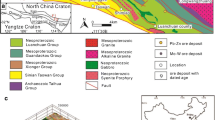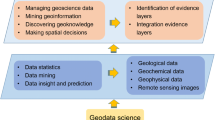Abstract
With the decrease in surface and shallow ore deposits, mineral exploration has focused on deeply buried ore bodies, and large-scale metallogenic prediction presents new opportunities and challenges. This paper adopts the predictive thinking method in this era of big data combined with specific research on the special exploration and exploitation of deep-earth resources. Four basic theoretical models of large-scale deep mineralization prediction and evaluation are explored: mineral prediction geological model theory, multidisciplinary information correlation theory, mineral regional trend analysis theory, and mineral prediction geological differentiation theory. The main workflow of large-scale deep resource prediction in the digital and information age is summarized, including construction of ore prospecting models of metallogenic systems, multiscale 3D geological modeling, and 3D quantitative prediction of deep resources. Taking the Lala copper mine in Sichuan Province as an example, this paper carries out deep 3D quantitative prediction of mineral resources and makes a positive contribution to the future prediction and evaluation of mineral resources.
Similar content being viewed by others
References Cited
Antoni, C., Eduardo, G. P., Lisard, T., et al., 2017. Mesozoic Volcanogenic Massive Sulfide (VMS) Deposits in Mexico. Ore Geology Reviews, 81: 1066–1083. https://doi.org/10.1016/j.oregeorev.2015.07.027
Carranza, E. J. M., 2009. Controls on Mineral Deposit Occurrence Inferred from Analysis of Their Spatial Pattern and Spatial Association with Geological Features. Ore Geology Reviews, 35(3/4): 383–400. https://doi.org/10.1016/j.oregeorev.2009.01.001
Chen, J. P., Lu, P., Wu, W., et al., 2007. A 3-D Prediction Method for Blind Ore-body Based on 3-D Visualization Model and Its Application. Earth Science Frontiers, 14(5): 54–61. https://doi.org/10.1016/s1872-5791(07)60035-9
Chen, J. P., Yu, P. P., Shi, R., et al., 2014. Research on Three-Dimensional Quantitative Prediction and Evaluation Methods of Regional Concealed Ore Bodies. Earth Science Frontiers, 21(5): 211–220 (in Chinese with English Abstract)
Chen, J. P., Xiang, J., Hu, Q., et al., 2016. Quantitative Geoscience and Geological Big Data Development: A Review. Acta Geologica Sinica—English Edition, 90(4): 1490–1515. https://doi.org/10.1111/1755-6724.12782
Gao, X. R., Wang, A. J., 2010. The Prediction of China’s Steel Demand Based on S-Shaped Regularity. Acta Geoscientica Sinica, 31(5): 645–652 (in Chinese with English Abstract)
Hagemann, S. G., Lisitsin, V. A., Huston, D. L., 2016. Mineral System Analysis: Quo Vadis. Ore Geology Reviews, 76(3): 504–522. https://doi.org/10.1016/j.oregeorev.2015.12.012
Li, N., Bagas, L., Li, X. H., et al., 2016. An Improved Buffer Analysis Technique for Model-Based 3D Mineral Potential Mapping and Its Application. Ore Geology Reviews, 76(2–3): 94–107. https://doi.org/10.1016/j.oregeorev.2015.12.002
Li, N., Song, X. L., Xiao, K. Y., et al., 2018. Part II: A Demonstration of Integrating Multiple-Scale 3D Modelling into GIS-Based Prospectivity Analysis: A Case Study of the Huayuan-Malichang District, China. Ore Geology Reviews, 95(1–4): 292–305. https://doi.org/10.1016/j.oregeorev.2018.02.034
Li, R. S., 1996. Theory and Practice of Metallogenic System Analysis. Geological Publishing House, Beijing (in Chinese)
Li, X. H., Yuan, F., Zhang, M. M., et al., 2015. Three-Dimensional Mineral Prospectivity Modeling for Targeting of Concealed Mineralization within the Zhonggu Iron Orefield, Ningwu Basin, China. Ore Geology Reviews, 71(5): 633–654. https://doi.org/10.1016/j.oregeorev.2015.06.001
Liang, X., Liu, S. G., Wang, S. B., et al., 2019. Analysis of the Oldest Carbonate Gas Reservoir in China—New Geological Significance of the Dengying Gas Reservoir in the Weiyuan Structure, Sichuan Basin. Journal of Earth Science, 30(2): 348–366. https://doi.org/10.1007/s12583-017-0962-y
Liu, H., Tan, X. C., Li, L., et al., 2019. Eogenetic Karst in Interbedded Carbonates and Evaporites and Its Impact on Hydrocarbon Reservoir: A New Case from Middle Triassic Leikoupo Formation in Sichuan Basin, Southwest China. Journal of Earth Science, 30(5): 908–923. https://doi.org/10.1007/s12583-019-0888-7
Liu, S. G., Deng, B., Jansa, L., et al., 2018. Multi-Stage Basin Development and Hydrocarbon Accumulations: A Review of the Sichuan Basin at Eastern Margin of the Tibetan Plateau. Journal of Earth Science, 29(2): 307–325. https://doi.org/10.1007/s12583-017-0904-8
Mao, X. C., 2010. 3D Visualization Prediction of Concealed Ore Bodies. Central South University Press, Changsha (in Chinese)
Mao, X. C., Chen, J., Deng, H., et al., 2014. 3D Quantitative Predictivity of Concealed Ore Bodies in Fenghuangshan Copper Deposit, Tongling District, China. Acta Geologica Sinica—English Edition, 88(s2): 454–456. https://doi.org/10.1111/1755-6724.12373_20
Mao, X. C., Dai, T. G., Wu, X. B., 2009. The Stereoscopic Quantitative Prediction of Concealed Ore Bodies in the Deep and Marginal Parts of Crisis Mines: A Case Study of the Dachang Tin Polymetallic Ore Deposit in Guangxi. Geology in China, 36(2): 424–435 (in Chinese with English Abstract)
Ouyang, Y., Liu, H. H., Wang, X., et al., 2019. Spatial Distribution Prediction of Laterite Bauxite in Bolaven Plateau Using GIS. Journal of Earth Science, 30(5): 1010–1019. https://doi.org/10.1007/s12583-019-1234-9
Sun, Y., Li, C. D., 1990. Mineralization Mechanism of Lala Copper Deposit in Sichuan Province. Journal of Chengdu College of Geology, 17(4): 1–9 (in Chinese with English Abstract)
Tang, J. X., Deng, S. L., Zheng, W. B., 2011. An exploration Model for Jiama Copper Polymetallic Deposit in Maizhokunggar County, Tibet. Mineral Deposits, 30(2): 179–196 (in Chinese with English Abstract)
Wang, D. H., Tang, J. X., Ying, L. J., 2010. Application of “Five Levels +Basement” Model for Prospecting Deposits into Depth. Journal of Jilin University (Earth Science Edition), 40(4): 733–738 (in Chinese with English Abstract)
Wang, G. W., Li, R. X., Carranza, E. J. M., et al., 2015. 3D Geological Modeling for Prediction of Subsurface Mo Targets in the Luanchuan District, China. Ore Geology Reviews, 71(1–4): 592–610. https://doi.org/10.1016/j.oregeorev.2015.03.002
Wang, G. W., Zhang, S. T., Yan, C. H., et al., 2011. Mineral Potential Targeting and Resource Assessment Based on 3D Geological Modeling in Luanchuan Region, China. Computers & Geosciences, 37(12): 1976–1988. https://doi.org/10.1016/j.cageo.2011.05.007
Wang, S. C., 2010. The New Development of Theory and Method of Synthetic Information Mineral Resources Prognosis. Geological Bulletin of China, 29(10): 1399–1403 (in Chinese with English Abstract)
Wyborn, L. A. I., Heinrich, C. A., Jauqes, A. L., 1994. Australian Proterozoic Mineral Systems: Essential Ingredients and Mappable Criteria. Journal of the City Planning Institute of Japan, 5(94): 109–115
Xiang, J., Chen, J. P., Bagas, L., et al., 2020. Southern China’s Manganese Resource Assessment: An Overview of Resource Status, Mineral System, and Prediction Model. Ore Geology Reviews, 116: 103261. https://doi.org/10.1016/j.oregeorev.2019.103261
Xiang, J., Xiao, K. Y., Carranza, E. J. M., et al., 2019. 3D Mineral Prospectivity Mapping with Random Forests: A Case Study of Tongling, Anhui, China. Natural Resources Research, 29(1): 395–414. https://doi.org/10.1007/s11053-019-09578-2
Xiao, K. Y., Cheng, S. L., Lou, D. B., 2010. Integrated Information Evaluation Model for Regional Mineral Resources Quantitative Assessment. Geological Bulletin of China, 29(10): 1430–1444 (in Chinese with English Abstract)
Xiao, K. Y., Li, N., Porwal, A., et al., 2015. GIS-Based 3D Prospectivity Mapping: A Case Study of Jiama Copper-Polymetallic Deposit in Tibet, China. Ore Geology Reviews, 71(11): 611–632. https://doi.org/10.1016/j.oregeorev.2015.03.001
Xiao, K. Y., Li, N., Sun, L., et al., 2012. Large Scale 3D Mineral Prediction Methods and Channels Based on 3D Information Technology. Journal of Geology, 36(3): 229–236 (in Chinese with English Abstract)
Xiao, K. Y., Lou, D. B., Sun, L., et al., 2013. Collected Model of Potential Evaluation for Important National Mineral Resources in China. Journal of Geology, 37(3): 341–348 (in Chinese with English Abstract)
Xiao, K. Y., Zhao, P. D., 1994. A Prelimnary Discussion on Basic Problems and Reseaching Progermming of the Large Scale Metallogenetic Prognosis. Geological Exploration for Non-Ferrous Metals, 1: 49–56 (in Chinese with English Abstract)
Yousefi, M., Kreuzer, O. P., Nykänen, V., et al., 2019. Exploration Information Systems—A Proposal for the Future Use of GIS in Mineral Exploration Targeting. Ore Geology Reviews, 111(3): 103005. https://doi.org/10.1016/j.oregeorev.2019.103005
Yuan, F., Li, X. H., Zhang, M. M., 2014. Three Dimension Prospectivity Modelling Based on Integrated Geoinformation for Prediction of Buried Ore Bodies. Acta Geologica Sinica, 88(4): 630–643 (in Chinese with English Abstract)
Zhai, Y. S., 1999. On the Metallogenic System. Earth Science Frontiers, 6(1): 13–27 (in Chinese with English Abstract)
Zhang, W. P., Yu, C., Li, F., et al., 2016. Geological Characteristics and Ore-Controlling Factors of Hongnipo Copper Deposit in Huili of Sichuan. Nonferrous Metals Engineering, 6(2): 80–84 (in Chinese with English Abstract)
Zhao, P. D., Hu, W. L., 1992. Geological Anomaly Theory and Mineral Resource Prognosis. Xinjiang Geology, 10(2): 93–100 (in Chinese with English Abstract)
Zhao, P. D., Li, Z. J., 1992. Statistical Prediction of Three-Dimensional Deposits in Key Metallogenic Regions: A Case Study of Yueshan Area, Anhui Province. China University of Geosciences Press, Wuhan (in Chinese)
Zhu, Y. S., 2006. Basic Theory of Mineral Resources Assessment-Theory System between Regional Metallogeny to Mineral Exporation. Acte Geologicasinica, 80(10): 1518–1527 (in Chinese with English Abstract)
Zuo, R. G., 2020. Geodata Science-Based Mineral Prospectivity Mapping: A Review. Natural Resources Research, 29(6): 3415–3424. https://doi.org/10.1007/s11053-020-09700-9
Author information
Authors and Affiliations
Corresponding author
Additional information
Acknowledgments
This research was financially supported by the National Natural Science Foundation of China (No. 42002298), the National Key Research and Development Program of China (No. 2017YFC0601501), China Geological Survey (No. DD20201181), and the Open Research Fund Program of the Key Laboratory of Metallogenic Prediction of Nonferrous Metals and Geological Environment Monitoring (Central South University), Ministry of Education (No. 2020YSJS09). The final publication is available at Springer via https://doi.org/10.1007/s12583-021-1437-8.
Rights and permissions
About this article
Cite this article
Xiao, K., Xiang, J., Fan, M. et al. 3D Mineral Prospectivity Mapping Based on Deep Metallogenic Prediction Theory: A Case Study of the Lala Copper Mine, Sichuan, China. J. Earth Sci. 32, 348–357 (2021). https://doi.org/10.1007/s12583-021-1437-8
Received:
Accepted:
Published:
Issue Date:
DOI: https://doi.org/10.1007/s12583-021-1437-8




